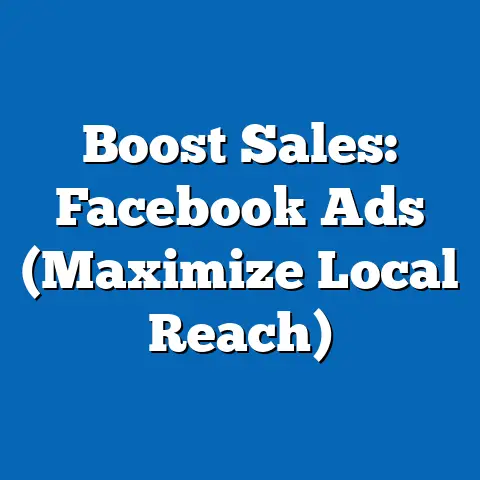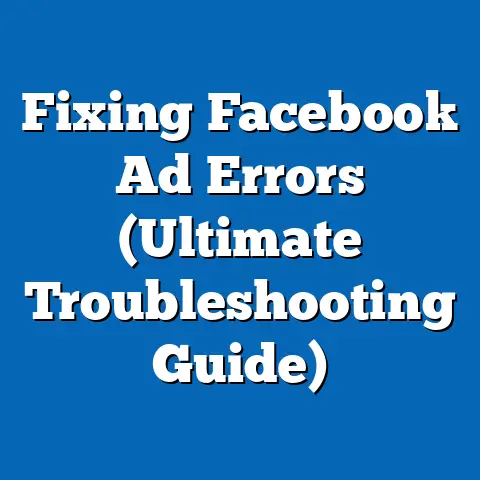Optimize HVAC Facebook Ads (Proven Strategies Revealed)
The modern homeowner, property manager, and even commercial business owner are BUSY. They don’t have time to constantly fiddle with their HVAC systems. That’s why ease of maintenance is a HUGE selling point. Think about it – when your air conditioner breaks down in the middle of summer, or your furnace quits in the dead of winter, the last thing you want is a complicated, expensive fix. You want something reliable, efficient, and easy to keep running.
That’s where you, the savvy HVAC business owner, come in. You offer those solutions! But how do you effectively communicate this crucial benefit to potential customers? The answer: targeted Facebook advertising.
Facebook, with its billions of active users, provides an unparalleled opportunity to connect with your ideal audience. But simply throwing up an ad and hoping for the best isn’t going to cut it. You need a strategic approach, one that emphasizes the ease of maintenance your HVAC systems offer.
Let’s dive in!
Section 1: Understanding Your Target Audience
Before you even think about creating an ad, you need to deeply understand who you’re trying to reach. Who are your ideal HVAC customers on Facebook? What are their needs, their pain points, and their motivations?
It’s not enough to just say “homeowners.” We need to get more specific. I’ve found that segmenting your audience is key to crafting ads that truly resonate.
Here are some key audience segments to consider:
- Homeowners: This is a broad category, but you can further segment it based on factors like age, income, location, and family status. Are you targeting first-time homebuyers who are looking for energy-efficient systems? Or are you targeting older homeowners who are looking to replace outdated, unreliable equipment?
- Property Managers: Property managers are responsible for maintaining HVAC systems in multiple properties. They are often looking for cost-effective, reliable solutions that minimize downtime and tenant complaints. Ease of maintenance is a huge selling point for this group.
- Commercial Businesses: Businesses need HVAC systems that can handle heavy usage and maintain a comfortable environment for employees and customers. They are often concerned with energy efficiency, reliability, and minimizing disruptions to their operations.
To truly understand these segments, you need to create detailed customer personas. A customer persona is a fictional representation of your ideal customer, based on research and data about your existing customers.
Here’s what to include in your customer personas:
- Demographics: Age, gender, location, income, education, family status.
- Psychographics: Interests, values, lifestyle, attitudes, personality.
- Pain Points: What challenges are they facing with their current HVAC system? What are their biggest frustrations?
- Motivations: What are they hoping to achieve by upgrading or replacing their HVAC system? What are their goals?
Example:
Let’s say you’re targeting homeowners in a suburban area who are concerned about energy costs. Your customer persona might look something like this:
- Name: Sarah Miller
- Age: 45
- Location: Suburb of Dallas, Texas
- Income: $80,000 per year
- Family Status: Married with two children
- Interests: Gardening, cooking, home improvement
- Pain Points: High energy bills, unreliable AC system, concerned about the environment
- Motivations: Lower energy costs, a more comfortable home, a more environmentally friendly lifestyle
Once you have a clear understanding of your target audience, you can start crafting ads that speak directly to their needs and motivations. For Sarah, an ad highlighting the energy efficiency and ease of maintenance of a new HVAC system would likely be very effective.
Takeaway: Understanding your target audience is the foundation of a successful Facebook ad campaign. Create detailed customer personas to guide your ad creation and targeting efforts.
Section 2: Crafting Compelling Ad Copy
Now that you know who you’re talking to, let’s talk about what you’re going to say. Your ad copy is your chance to grab their attention and convince them that your HVAC services are the right choice.
The key to effective ad copy is clarity and conciseness. People are scrolling through their Facebook feeds quickly, so you need to get your message across in a clear and compelling way.
Here are some essential elements of effective ad copy for HVAC Facebook ads:
- Headline: Your headline is the first thing people will see, so it needs to be attention-grabbing and relevant. Use strong keywords that will resonate with your target audience.
- Body Text: Your body text should provide more detail about your offer and the benefits of your services. Highlight the ease of maintenance of your HVAC systems.
- Call to Action (CTA): Your CTA should tell people exactly what you want them to do. Use strong action verbs like “Call Now,” “Get a Free Quote,” or “Learn More.”
Highlighting Ease of Maintenance:
Here are some tips on how to highlight ease of maintenance in your ad copy:
- Use Customer Testimonials: Include quotes from satisfied customers who have praised the ease of maintenance of your HVAC systems. For example: “I love my new HVAC system from [Your Company]! It’s so easy to maintain, and I haven’t had any problems with it since it was installed.”
- Emphasize Warranties: A strong warranty can provide peace of mind to potential customers. Highlight the length and coverage of your warranties in your ad copy.
- Showcase Energy-Efficient Models: Energy-efficient models often require less maintenance and can save customers money on their energy bills.
- Focus on Longevity: Mention the expected lifespan of your HVAC systems. Customers want to know that they’re investing in a product that will last.
Strong Call to Action:
Your CTA is the final piece of the puzzle. It’s the nudge that encourages people to take the next step. Make sure your CTA is clear, concise, and relevant to your offer.
Here are some examples of strong CTAs for HVAC Facebook ads:
- Call Now for a Free Estimate! (This is a great option if you want to generate leads quickly.)
- Get a Free Quote on a New HVAC System! (This is a good option if you want to collect leads and provide personalized quotes.)
- Learn More About Our Low-Maintenance HVAC Systems! (This is a good option if you want to educate your audience and build trust.)
- Schedule Your Annual HVAC Maintenance Checkup! (Perfect for reaching existing customers)
Examples of Successful Ad Copy:
Here are a couple of examples of successful ad copy that I’ve seen resonate with HVAC customers:
Example 1 (Targeting Homeowners):
Headline: Tired of High Energy Bills and Constant HVAC Repairs?
Body Text: Upgrade to a new, energy-efficient HVAC system from [Your Company] and start saving money today! Our systems are designed for easy maintenance and long-lasting performance. Plus, we offer a comprehensive warranty for your peace of mind.
CTA: Get a Free Quote!
Example 2 (Targeting Property Managers):
Headline: Reduce Maintenance Costs and Tenant Complaints with Reliable HVAC Systems
Body Text: As a property manager, you need HVAC systems that are reliable, efficient, and easy to maintain. [Your Company] offers a wide range of HVAC solutions designed to minimize downtime and tenant complaints.
CTA: Learn More!
Takeaway: Crafting compelling ad copy is essential for attracting attention and driving conversions. Focus on clarity, conciseness, and highlighting the ease of maintenance of your HVAC systems. Don’t forget a strong call to action!
Section 3: Visual Elements and Ad Design
In the world of Facebook ads, visuals are king (or queen!). Your images and videos are the first thing people will notice, so they need to be eye-catching, relevant, and professional.
For the HVAC industry, visual elements can be particularly effective in conveying ease of maintenance.
Here are some best practices for selecting images and videos for your HVAC Facebook ads:
- Showcase Technicians Performing Easy Maintenance Tasks: Images or videos of technicians performing simple tasks like changing filters or cleaning coils can effectively communicate the ease of maintenance of your systems.
- Feature Satisfied Customers: Images or videos of happy customers enjoying the comfort of their homes can build trust and credibility.
- Highlight Energy-Efficient Models: Use images or videos that showcase the sleek design and advanced features of your energy-efficient HVAC systems.
- Focus on Cleanliness and Organization: Images of clean, well-maintained HVAC systems can convey a sense of reliability and professionalism.
Ad Formats:
Facebook offers a variety of ad formats that can enhance engagement. Here are a few options to consider:
- Carousel Ads: Carousel ads allow you to showcase multiple images or videos in a single ad. This is a great option for highlighting different features of your HVAC systems or showcasing different customer testimonials.
- Video Ads: Video ads are highly engaging and can be used to tell a story or demonstrate the benefits of your services. Consider creating a video that shows how easy it is to maintain your HVAC systems.
- Slideshow Ads: Slideshow ads are a cost-effective way to create a video-like experience using a series of images.
- Single Image Ads: Sometimes, a single, high-quality image is all you need to grab attention. Make sure your image is relevant to your offer and visually appealing.
Branding:
Your branding is an important part of your visual elements. Use your logo, colors, and fonts consistently in all of your ads to build brand recognition and trust.
Here are some tips for using branding effectively in your HVAC Facebook ads:
- Include Your Logo: Make sure your logo is prominently displayed in your ads.
- Use Your Brand Colors: Use your brand colors in your ad design to create a cohesive look and feel.
- Use Your Brand Fonts: Use your brand fonts in your ad copy to maintain consistency.
- Maintain a Consistent Tone: Use a consistent tone of voice in all of your ads to reinforce your brand identity.
Takeaway: Visual elements are crucial for attracting attention and conveying your message effectively. Choose images and videos that are relevant to your offer, visually appealing, and consistent with your branding. Experiment with different ad formats to see what works best for your target audience.
Section 4: Targeting and Retargeting Strategies
You’ve got a killer ad with compelling copy and stunning visuals. Now, you need to make sure it’s seen by the RIGHT people. That’s where targeting comes in. Facebook offers a wealth of targeting options, allowing you to reach specific demographics, interests, and behaviors.
Here’s a breakdown of some key targeting options:
- Location Targeting: Target people who live in specific cities, states, or zip codes. This is essential for HVAC businesses that serve a local area.
- Demographic Targeting: Target people based on age, gender, education, income, and other demographic factors.
- Interest Targeting: Target people based on their interests, hobbies, and activities. For example, you could target people who are interested in home improvement, gardening, or energy efficiency.
- Behavior Targeting: Target people based on their online behavior, such as their purchase history, website visits, and Facebook activity.
Lookalike Audiences:
One of the most powerful targeting options on Facebook is lookalike audiences. A lookalike audience is a group of people who share similar characteristics to your existing customers.
To create a lookalike audience, you need to upload a list of your existing customers to Facebook. Facebook will then analyze the data and identify common traits among your customers. It will then find other people on Facebook who share those same traits.
Lookalike audiences can be incredibly effective for reaching new customers who are likely to be interested in your services.
Custom Audiences:
Custom audiences allow you to target people who have already interacted with your business in some way. For example, you can target people who have visited your website, watched your videos, or liked your Facebook page.
Custom audiences are a great way to re-engage people who are already familiar with your brand.
Retargeting:
Retargeting is a specific type of custom audience that targets people who have visited your website but haven’t yet converted into customers.
Retargeting ads can be incredibly effective for HVAC businesses. According to industry data, retargeting can improve conversion rates by as much as 150%.
Here’s how retargeting works:
- You install a Facebook Pixel on your website.
- The Facebook Pixel tracks the behavior of visitors to your website.
- When someone visits your website but doesn’t convert, they are added to your retargeting audience.
- You create ads that are specifically targeted to your retargeting audience.
Your retargeting ads can remind people about your services and encourage them to take the next step.
Strategies for Retargeting Campaigns Focusing on Ease of Maintenance:
- Showcase Customer Testimonials: Feature testimonials from satisfied customers who have praised the ease of maintenance of your HVAC systems.
- Offer a Discount: Offer a discount on your services to encourage people to convert.
- Highlight Warranties: Remind people about the comprehensive warranties you offer on your HVAC systems.
- Provide Educational Content: Share blog posts or articles that explain the benefits of low-maintenance HVAC systems.
Takeaway: Targeting and retargeting are essential for reaching the right audience and maximizing your ROI. Use a combination of location, demographic, interest, and behavior targeting to reach new customers. Create lookalike audiences to expand your reach. And don’t forget to retarget people who have visited your website but haven’t yet converted.
How much should you be spending on your Facebook ad campaigns? And how should you be bidding for ad placements?Setting a budget for your Facebook ad campaigns is a crucial step. You need to determine how much you’re willing to spend to acquire a new customer.
Here’s how to set a budget for your HVAC Facebook ad campaigns:
- Determine Your Cost-Per-Acquisition (CPA): Your CPA is the amount you’re willing to spend to acquire a new customer. To calculate your CPA, you need to know your average profit per customer and your desired return on investment (ROI).
- Set a Daily or Lifetime Budget: Facebook allows you to set a daily or lifetime budget for your ad campaigns. A daily budget is the amount you’re willing to spend each day. A lifetime budget is the total amount you’re willing to spend over the entire duration of your campaign.
- Monitor Your Ad Performance: Regularly monitor your ad performance to see how much you’re spending and how many customers you’re acquiring. Adjust your budget as needed to optimize your ROI.
Bidding Strategies:
Facebook offers a variety of bidding strategies that you can use to optimize your ad campaigns. Here are a few of the most common bidding strategies:
- Cost-Per-Click (CPC): With CPC bidding, you pay each time someone clicks on your ad. This is a good option if you want to drive traffic to your website.
- Cost-Per-Impression (CPM): With CPM bidding, you pay for every 1,000 impressions of your ad. This is a good option if you want to increase brand awareness.
- Cost-Per-Action (CPA): With CPA bidding, you pay only when someone takes a specific action, such as filling out a form or making a purchase. This is a good option if you want to generate leads or drive sales.
Choosing the Right Bidding Strategy for HVAC Ads:
The best bidding strategy for your HVAC ads will depend on your goals and your budget.
If you’re just starting out, I recommend starting with CPC bidding. This will allow you to drive traffic to your website and learn more about your target audience.
Once you have more data, you can experiment with other bidding strategies, such as CPA bidding. CPA bidding can be a great option for generating leads or driving sales, but it requires more data and optimization.
Tips for Monitoring and Adjusting Budgets:
- Track Your Key Performance Indicators (KPIs): Track your click-through rate (CTR), conversion rate, and return on ad spend (ROAS) to see how your ads are performing.
- Adjust Your Bids Based on Performance: If your ads are performing well, you can increase your bids to reach more people. If your ads are not performing well, you can decrease your bids to save money.
- Experiment with Different Targeting Options: Try targeting different demographics, interests, and behaviors to see what works best for your target audience.
- Split Test Your Ads: Split test different ad copy, images, and CTAs to see what resonates best with your target audience.
Takeaway: Setting a budget and choosing the right bidding strategy are essential for maximizing your ROI. Determine your CPA, set a daily or lifetime budget, and monitor your ad performance regularly. Experiment with different bidding strategies and targeting options to see what works best for your business.
Section 6: Measuring Success and Analytics
You’ve launched your ad campaigns, you’re targeting the right audience, and you’re bidding strategically. Now, how do you know if it’s all working? That’s where analytics comes in.
Tracking key performance indicators (KPIs) is essential for measuring the success of your HVAC Facebook ads.
Here are some of the most important KPIs to track:
- Click-Through Rate (CTR): Your CTR is the percentage of people who see your ad and click on it. A high CTR indicates that your ad copy and visuals are resonating with your target audience.
- Conversion Rate: Your conversion rate is the percentage of people who click on your ad and then take a desired action, such as filling out a form or making a purchase. A high conversion rate indicates that your landing page and offer are compelling.
- Cost-Per-Acquisition (CPA): Your CPA is the amount you’re spending to acquire a new customer. A low CPA indicates that your ad campaigns are efficient and effective.
- Return on Ad Spend (ROAS): Your ROAS is the amount of revenue you’re generating for every dollar you spend on advertising. A high ROAS indicates that your ad campaigns are profitable.
Setting Up Facebook Pixel:
To track user behavior and conversions on your HVAC website, you need to set up the Facebook Pixel.
The Facebook Pixel is a small piece of code that you place on your website. It tracks the actions that people take on your website, such as visiting pages, adding items to their cart, and making purchases.
You can use the Facebook Pixel to create custom audiences, track conversions, and optimize your ad campaigns.
Tools and Metrics for Analyzing Ad Performance:
Facebook offers a variety of tools and metrics that you can use to analyze your ad performance.
Here are a few of the most useful tools and metrics:
- Facebook Ads Manager: Facebook Ads Manager is the primary tool for managing your Facebook ad campaigns. It provides a wealth of data on your ad performance, including your CTR, conversion rate, CPA, and ROAS.
- Facebook Analytics: Facebook Analytics provides insights into the behavior of people who visit your website and use your app. You can use Facebook Analytics to track user demographics, interests, and behaviors.
- Google Analytics: Google Analytics is a powerful web analytics tool that provides detailed insights into the behavior of visitors to your website. You can use Google Analytics to track your website traffic, bounce rate, and conversion rate.
Making Data-Driven Decisions:
The key to maximizing your ROI is to use data to make informed decisions about your ad campaigns.
Here are some tips for making data-driven decisions:
- Track Your KPIs Regularly: Track your KPIs on a daily or weekly basis to see how your ads are performing.
- Identify Trends and Patterns: Look for trends and patterns in your data to see what’s working and what’s not.
- Experiment with Different Strategies: Experiment with different targeting options, bidding strategies, and ad creatives to see what works best for your target audience.
- Continuously Optimize Your Campaigns: Continuously optimize your campaigns based on your data to improve your ROI.
Takeaway: Measuring success and analyzing your ad performance is essential for maximizing your ROI. Track your KPIs, set up the Facebook Pixel, and use the tools and metrics available to you to make data-driven decisions about your ad campaigns.
Conclusion
Optimizing your HVAC Facebook ads is an ongoing process. By understanding your target audience, crafting compelling ad copy, leveraging powerful visual elements, targeting the right people, and measuring your success, you can create ad campaigns that attract new customers and generate a positive ROI.
Remember, ease of maintenance is a key selling point for HVAC systems. Highlight this benefit in all of your advertising efforts to resonate with your target audience.
I encourage you to implement these strategies and continuously refine your approach based on performance data to achieve better results in your Facebook advertising campaigns. The HVAC market is competitive, but with a strategic and data-driven approach, you can stand out from the crowd and attract the customers you deserve.
Good luck, and happy advertising!




